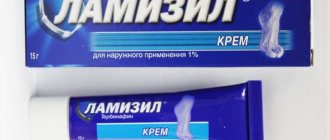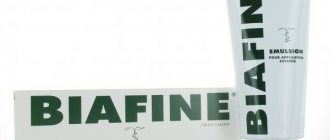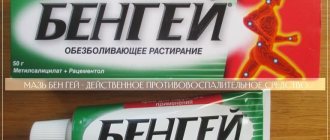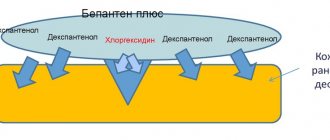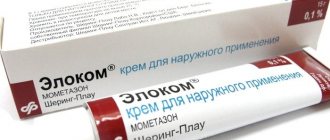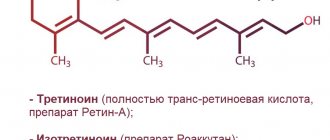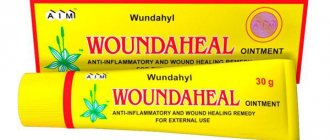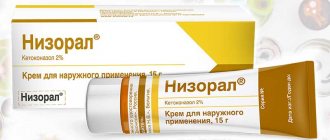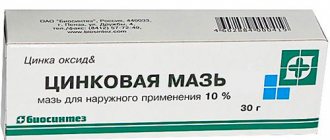Release form and composition
Laticort is available in three dosage forms for external use:
- Cream 0.1%: white homogeneous mass (15 g in aluminum tubes, 1 tube in a cardboard box);
- Ointment 0.1%: almost colorless, transparent fatty mass (15 g in aluminum tubes, 1 tube in a cardboard box);
- Solution 0.1%: transparent, colorless, without mechanical inclusions and sediment, has the smell of isopropyl alcohol (20 ml in polyethylene bottles, 1 bottle in a cardboard box).
The composition of 1000 mg of cream includes:
- Active ingredient: hydrocortisone butyrate – 1 mg;
- Auxiliary components: liquid paraffin - 60 mg, white petrolatum - 150 mg, cetomacrogol - 18 mg, cetostearyl alcohol - 72 mg, methyl parahydroxybenzoate - 2 mg, citric acid - 4.2 mg, sodium citrate - 2.8 mg, purified water - up to 1000 mg.
The composition of 1000 mg ointment includes:
- Active ingredient: hydrocortisone butyrate – 1 mg;
- Auxiliary components: white petroleum jelly – up to 1000 mg.
The composition of 1 ml of solution includes:
- Active ingredient: hydrocortisone butyrate – 1 mg;
- Auxiliary components: povidone - 2.5 mg, glycerol - 30 mg, citric acid - 1.72 mg, isopropanol - 0.5 mg, sodium citrate - 0.78 mg, purified water - up to 1 ml.
Pharmacological properties
Pharmacodynamics
The active ingredient of Laticort is hydrocortisone butyrate, a glucocorticosteroid for external use with anti-inflammatory, antiallergic, antipruritic and antiexudative effects that reduces capillary permeability.
Hydrocortisone inhibits the activity of phospholipase A2, as a result of which the synthesis of prostaglandins and leukotrienes is suppressed. The drug inhibits the migration of lymphocytes and leukocytes to the site of inflammation. Inhibits the growth of fibroblasts, inhibits the proteolytic activity of tissue kinins, and prevents the development of connective tissue at the site of inflammation. Reduces hyperemia and manifestations of hypersensitivity reactions. Reduces exudative and proliferative processes occurring in the connective tissue at the site of inflammation.
Pharmacokinetics
After Laticort is applied to the skin, hydrocortisone butyrate easily penetrates the stratum corneum of the skin and enters the systemic bloodstream in small quantities. Absorption of the drug increases when it is used over large areas of the body, applied to the skin of the face or in the area of skin folds, and long-term use under occlusive dressings.
In children, absorption of the substance from the epidermis is more pronounced than in adults. Hydrocortisone butyrate can accumulate in the cells of the stratum corneum of the skin.
The drug is biotransformed directly in the epidermis, and the absorbed amount of the substance is in the liver. As a result of metabolism, products are formed - hydrocortisone and butyric acid, which are quickly eliminated from the body.
Considering the peculiarities of kinetics and the absence of halogens in the formula, the risk of developing local and systemic side effects is minimal.
Pharmacokinetics
Suction
After application, the active substance accumulates in the epidermis, mainly in the granular layer.
Metabolism
Hydrocortisone 17-butyrate, absorbed through the skin, is metabolized to hydrocortisone and other metabolites directly in the epidermis and subsequently in the liver.
Removal
Metabolites and a small portion of unchanged hydrocortisone 17-butyrate are excreted in urine or feces.
Contraindications
- Skin infections of bacterial, viral and fungal etiology;
- Syphilitic or tuberculous skin lesions;
- Perioral dermatitis;
- Rosacea, acne vulgaris;
- Skin tumors;
- Violations of the integrity of the skin (wounds, ulcers);
- Post-vaccination period;
- Age up to 6 months, with itching in the anus - up to 12 years;
- Hypersensitivity to the components of the drug.
Laticort is prescribed with caution to patients with diabetes mellitus and tuberculosis (with systemic damage).
Pregnant women can use the drug only as prescribed by a doctor after assessing the ratio of potential benefits to possible risks. Laticort can be applied to small areas of the skin for a short period of time. In the first trimester of pregnancy, the use of the drug is not recommended.
During lactation, short-term therapy can be carried out by applying the drug to small areas of the skin. Laticort should not be used on the skin of the breast.
Indications for use
There are quite a few different indications for the use and daily use of Laticort. Among the most common of them are:
- Psoriasis.
- Atopic, allergic and seborrheic chronic dermatitis.
- Eczema.
- Erytomatous eruptions and skin rashes.
- Photodermatosis.
Laticort, as an external treatment, is used to eliminate non-infectious skin pathologies, which are characterized by increased sensitivity to hormonal substances present in the medication.
Instructions for use of Laticort: method and dosage
Laticort is used externally.
The recommended dosage regimen for adults is 1-3 times a day. The drug should be applied in small quantities with massaging movements to the affected areas of the skin. Course duration is 1-3 weeks. During the week, the total dose of the drug should not exceed 30-60 g. In case of resistant disease, for example, with dense psoriatic plaques localized on the knees and elbows, Laticort should be used under occlusive dressings.
The drug is prescribed to children from 6 months of age. Due to the more rapid development of suppression of adrenal cortex function and the likelihood of decreased excretion of growth hormone when using Laticort in children over a long course, height, body weight, and plasma cortisol levels should be monitored.
When applying the drug to the face or under occlusive dressings (diapers, diapers), absorption occurs to a greater extent, therefore the use of minimal doses of the drug is recommended. Therapy should be short-term and under medical supervision.
Reviews
Positive reviews of Laticort are due to the budget price of the drug and its effectiveness.
Olga, 48 years old. I get psoriasis from time to time, after another consultation the doctor prescribed Laticort. I can’t say anything bad about the effectiveness; the plaques disappear quickly, and itching and flaking don’t bother me on the second day. The only thing that puzzled me is that all the ingredients are cheap, it seems to me that the cost of the drug is overpriced.
Alexey, 29 years old. Suffer from psoriasis on the elbows. Since I work in a pharmacy, with people, I need to get rid of plaques and peeling immediately. There was an opportunity to study different creams, and my choice fell on Laticort because of its cheapness. I am pleased with the result, the itching goes away almost immediately, the remaining visual manifestations are on the third day. Additionally, I apply a bandage so as not to stain my clothes. While I was being treated, I used a little more than half the tube.
Anastasia, 24 years old. My psoriasis worsened once again after my dismissal, that is, there was stress. The doctor prescribed Laticort, everything itched terribly. Of course, I’m happy with the effect, but the tubes of cream are very small. Personally, it took me 3 tubes until I completely got rid of psoriasis.
Side effects
Side effects are rare. Disorders that develop during the use of Laticort are usually reversible.
In rare cases, local reactions may occur, manifested in the form of skin irritation, as well as allergic contact dermatitis.
With prolonged therapy and/or application of Laticort to large areas, when using occlusive dressings, in some cases, disorders such as folliculitis, acne-like changes, prickly heat, hypopigmentation, stretch marks, secondary skin infections, hypertrichosis, skin atrophy may develop.
special instructions
Laticort ointment is recommended for use in lichenification and subacute inflammatory conditions. Laticort cream is advisable to use for acute inflammatory conditions with weeping.
Avoid contact of the drug with the eyes.
If a secondary infection of fungal or bacterial etiology develops, external antibacterial or antifungal drugs should be used.
Particular caution is required when using Laticort on the skin of the face, which is associated with the likelihood of side effects (atrophy, telangiectasia, perioral dermatitis).
In cases where after 7 days of therapy the condition does not improve, or, on the contrary, worsens, as well as when symptoms recur a few days after discontinuation of the drug, it is necessary to stop using Laticort and consult a specialist.
Despite the fact that prolonged use of high doses of the drug, especially when using occlusive dressings, can lead to an increase in cortisol levels in the blood plasma, this is never accompanied by a decrease in the reactivity of the pituitary-adrenal system. After discontinuation of therapy, cortisol production quickly normalizes.
The likelihood of developing side effects during the use of Laticort is lower than with therapy with halogenated glucocorticosteroids.
Caution should be observed when using the drug in patients with atrophic skin conditions, especially in elderly patients.
Impact on the ability to drive vehicles and complex mechanisms
The components of the solution, ointment and cream Laticort do not have a negative effect on the patient’s psychophysical functions, in particular the ability to drive a car and perform potentially dangerous types of work.
Analogs
If the patient is unable to purchase Laticort due to the high cost, you can consider more affordable analogues - Hydrocortisone or Solu-Cortef. If the medication cannot be used due to intolerance to the substances included in the composition, it can be replaced with other, albeit more expensive, drugs, but with a similar effect. The most effective of them include:
- Posterisan and Posterisan forte;
- Lokoid and Lokoid kipokrem;
- Cortef;
- Pimafukort.
If after a week of treatment the patient does not show positive dynamics, if the condition worsens, Laticort treatment should be stopped and a doctor should be consulted regarding a different treatment regimen.
Use during pregnancy and lactation
In the first trimester of pregnancy, the use of Laticort is not recommended.
In the second and third trimesters, the drug can only be used as prescribed by a doctor, who will assess the ratio of expected benefits and potential risks. Laticort should only be used on small areas of skin and treatment should be short-lived.
During lactation, the drug is approved for use with caution. The drug should be used on small surfaces of the skin, for a short time. Do not apply to breast skin.
Drug interactions
The local use of glucocorticoids in combination with other medications has not been formally studied. Vaccination in combination with the drug in question is unacceptable, especially if large areas of skin are treated with Laticort.
Refusal to vaccinate is due to the possible lack of an immunological response, that is, antibodies may not be produced. Combined use with immunostimulants can either enhance the effect of the latter or suppress it.
Use in childhood
Laticort is approved for use from the age of 6 months.
Children may develop adrenal suppression more quickly than adults. In addition, there may be a decrease in growth hormone excretion. If Laticort is used long-term, plasma cortisol levels, body weight and height of the child should be monitored. According to the results of control studies in which children received Laticort in different dosage forms in weekly doses of 30–60 g, no dysfunction of the adrenal cortex was detected.
When using Laticort on the face or under an occlusive dressing (diaper/diaper), the drug should be applied in minimal doses. Treatment must be carried out in a minimally short course and under the supervision of a doctor.
For itching in the anus, the drug is approved for use in children over 12 years of age.
Overdose
Exceeding the dose and using the product on large areas of the affected epidermis can lead to the following negative consequences:
- Cushing's syndrome develops with severe overdose;
- Increased blood pressure, decreased immune functions of the body, the appearance of swelling;
- Hypercortisolism requires immediate discontinuation of the drug.
Since there is no specific antidote, symptomatic treatment is used to eliminate the symptoms of overdose, and the use of Laticort should be discontinued or the dosage reduced.

